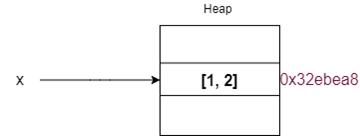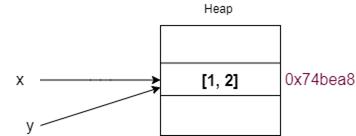本文转载自公众号“读芯术”(ID:AI_Discovery)
本文将会为你介绍Python引用计数,演示中使用可变列表对象,不过本文不介绍C语言实现细节。
需要注意的是,代码段的输出在硬件上可能有所不同。
变量是内存引用
Python中的变量是内存引用。如果输入x = [1,2]时会发生什么?[1,2]是对象。
回想一下,一切都是Python中的对象。[1,2]将在内存中创建。x是[1,2]对象的内存引用。
来看看下面的例子。可以找到x所引用的内存地址。请务必只使用id(x),它会以10为基数,而十六进制函数会将其转换为十六进制。
- x = [1, 2]
- print(hex(id(x))) # output: 0x32ebea8

引用计数
现在已经在内存中创建了一个list对象,而且x对该对象进行了引用。那么y=[1,2]和y=x有什么区别?
当输入y=[1,2]时,它将在内存中创建一个新的list对象,并且y将引用它。
- x = [1, 2]
- y = [1, 2]
- print(hex(id(x))) # output: 0x101bea8
- print(hex(id(y))) # output: 0x31a5528
而当输入y=x时,等同于告诉Python希望y 变量引用x变量引用的内容。因为变量是内存引用的。
可以确认x和y引用同一个对象。
- x = [1, 2]
- y = x
- print(hex(id(x))) # output: 0x74bea8
- print(hex(id(y))) # output: 0x74bea8

引用计数的数目
接下来的问题是,有多少变量引用同一个对象?
错误的用法:
我看到有些人在使用sys.getrefcount(var)时不知道如何传递var,而是向对象添加引用。一起看看下面的例子。
输出3,而期望的却是2(x andy)。发生这种情况是因为将x传递给getrefcount函数时又添加了一个引用。
- from sys import getrefcount
- x = [1, 2]
- y = x
- print(hex(id(x))) # output: 0xb65748
- print(hex(id(y))) # output: 0xb65748
- print(getrefcount(x)) # output: 3
更好的用法:
可以使用内置的ctypes模块来找到预期的结果。必须将x的id传递给from_address函数。
- from ctypes import c_long
- x = [1, 2]
- y = x
- print(hex(id(x))) # output: 0x3395748
- print(hex(id(y))) # output: 0x3395748
- print(c_long.from_address(id(x)).value) # output: 2
概言之,错误的用法是传递变量,而更好的用法则是传递变量的id,这意味着只传递基数为10的数字,而不是变量。
当对象消失时
当没有变量引用对象时会发生什么?
对象将从内存中删除,因为没有引用该对象的内容。不过也有例外:如果有循环引用,garbage collector 将开始奏效。
为什么使用可变对象
不可变对象由于性能原因,结果可能与预期不同。查看下面的例子,观察输出是如何变化的。
- import sys
- import ctypes
- """Some Mutable Objects """
- a =list()
- b =set()
- c =dict()
- d =bytearray()
- """ Some ImmutableObjects """
- e =tuple()
- f =int()
- g =str()
- print(sys.getrefcount(a),ctypes.c_long.from_address(id(a)).value) # output: 2 1
- print(sys.getrefcount(b),ctypes.c_long.from_address(id(b)).value) # output: 2 1
- print(sys.getrefcount(c),ctypes.c_long.from_address(id(c)).value) # output: 2 1
- print(sys.getrefcount(d),ctypes.c_long.from_address(id(d)).value) # output: 2 1
- print(sys.getrefcount(e),ctypes.c_long.from_address(id(e)).value) # output: 1298 1297
- print(sys.getrefcount(f),ctypes.c_long.from_address(id(f)).value) # output: 209 208
- print(sys.getrefcount(g),ctypes.c_long.from_address(id(g)).value) # output: 59 58
文中所谈及的一切都对CPython有效。希望对你有帮助。































